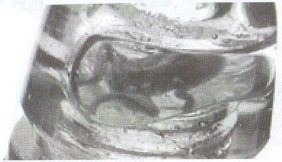The Frog and The Prince
By Dwayne Anthony
Reprinted from "Crown Jewels of the Wire", April 2004, page 10
The insulator pictured on the inside front cover made its first appearance at
the 1993 Enchantment Insulator Club Show in Los Lunas, New Mexico. A small
group of collectors had gathered in the lobby of the host motel in the afternoon
before the Friday evening show setup. Ross Thompson of Tucson, Arizona, (our
Prince in this story) was present and casually mentioned his discovery of a
beehive insulator with what appeared to be a frog encapsulated in a large dome
bubble. He was enthusiastically urged by the several collectors present to
produce and share this exciting discovery. Prince Ross briefly slipped away to
his motel room and returned shortly thereafter with a CD 145 B beehive in one
hand. As the small crowd gathered around, it was immediately apparent that the
insulator contained a large dome bubble with some form of an inclusion, but was
it really a frog?

After a brief examination, most agreed that it appeared to be in the form of
a small frog, but the uncertainty of such an anomaly actually occurring created
cause for closer inspection. Two collectors shuffled over to a large well-lit
window for a closer examination of the oddity. When held up to the direct bright
light of the late afternoon New Mexico sun, the full carcass of a small frog was
immediately confirmed, right down to the explicit details of its tiny webbed
feet! But how could this be? Wouldn't the intense heat of the molten glass burn
the frog beyond recognition? One longtime collector speculated that the gases
within the bubble put the frog into a state of suspended animation, protecting
and insulating it from contact with the molten glass. With this rather convincing
non-scientific hypothesis, it was concluded that this was one of the most
incredible insulator discoveries ever!
Later that evening and for the duration of the show, Prince Ross proudly
displayed the "frog beehive" on his sales table. It created quite a
stir and was the undeniable hit of the show. Offers of cash and trades abounded,
but the Prince held firm to his decision to keep it in his possession, since it
was such a remarkable rarity. One persistent collector finally made such a
ridiculously high offer that Prince Ross had to pull him outside for a private
chat. Although the month was October, not April, the relentless collector
proceeded to learn what the readers of this story are now about to learn: the
frog insulator was created as a gag! In turn, the story told under this month's
Insulator of the Month photograph is also a gag! APRIL FOOLS!
The truth of the matter is that Ross found the deceased frog out by his
backyard pond, the victim of his cat's instinctive hunting habits. He slipped
the frog into the insulator's bubble through a small opening near the top of the
pinhole threads and filled the void with clear resin, sealing off any sign of
the bubble's opening. It was a great gag and Ross asked at the time that the
true story be kept secret for future pranks. Shortly after this October 1993
show, Ross, along with his frog insulator, disappeared from the hobby, not to be
heard from again until 2003 (he took on a nine year job in the South Pacific).
During the last ten years, stories of the infamous frog insulator would surface
surface within collector circles across the country. Finally, at the 2004 Yuma,
Arizona insulator tailgater, Ross once again appeared with the frog insulator.
A handful of unsuspecting collectors were again fooled into believing that the
insulator was genuine. It was near the closing of the event that ownership of
this legendary insulator was transferred to me, along with permission to give
full testimony of its illustrious history. (The names of certain collectors
mentioned in the preceding true story were withheld to protect the
"embarrassed".)
I'm sure the Insulator of the Month photo fooled no one, right? After all, we
all know that the approximate 2,000 degree Fahrenheit temperature of molten
glass will instantly vaporize any organic material that comes in contact with
it, including frogs. The only lasting remnants such a poor unfortunate little
frog could generate in an insulator would be a large air bubble. Gases produced
from the instant vaporization of organic matter will create air pockets in
molten glass. If the gas pocket does not rise to the surface of the molten glass
and burst, it will appear in the form. of an air bubble in the finished product.
Next time you see a large bubble in an insulator, who knows, you just might be
observing the final tomb of a vaporized amphibian that once inhabited the
Prince's frog pond!
|
